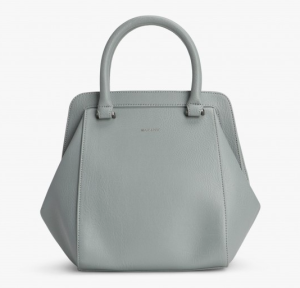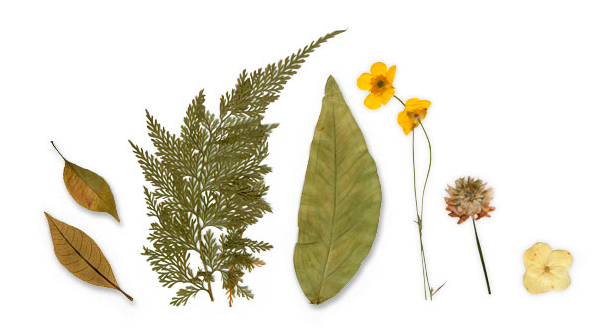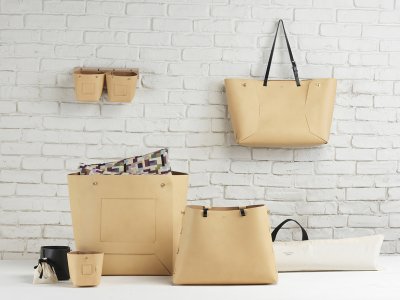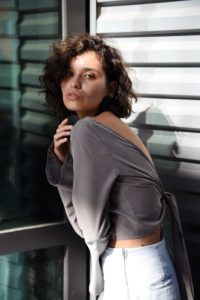Choosing leather ethically can be tricky. I’ve deciphered some of the popular options and brands to help you cut through the marketing and get to the truth.
I learned these lessons first-hand when my mom asked for my birthday wish-list, and kindly obliged to my request for an ethical, faux leather handbag.

After some research, I settled on this Matt & Nat bag. It’s supple, neutral and ladylike – and couldn’t be more classic. Matt & Nat has been delivering designs under the umbrella of ‘vegan leather’ since 1995. They use recycled nylons, cardboard, rubber and cork instead of traditional, manufactured leather substitutes.
It turns out, however, that Matt & Nat’s standard is the exception to the rule. Most vegan leather brands rely on cheap Polyvinyl Chloride (PVC), a synthetic material that’s carbon-intensive, doesn’t biodegrade, and leaches toxins into landfills. After 20 years of Matt & Nat delivering beautiful vegan leather goods at accessible price points, I thought other brands would have adopted their model. I was so wrong.
All this time, if you’ve been buying vegan or fake leather as a conscious decision for the environment and animals, you’ve been lead astray. This misinformation leaves us in a bind. How do we, as conscious consumers, decipher what’s ethical and what’s BS when it comes to leather?
From shoes, to bags, to belts, to notebooks – leather is the fashion industry’s default symbol for quality. It is also, unfortunately, wrought with ethical issues. That leaves us as consumers wondering how to make the right decisions. You might want to crawl under a rock at this point, but stay with me. There are some seriously complex forces at work in the leather industry, but I started investigating them after my handbag experience. I learned a few things that will help. In all honesty, we as consumers make the decision as to whether we want to purchase these types of products. Clothing Manufacturers make products that will sell. Whatever a business thinks will sell is what they will ask more of to be made.
There are two primary concerns when it comes to leather, the fair treatment of animals and pollution. Animal abuse in the industry is widespread and shocking. The details are well-documented, but because they are gory, I won’t get into them here. Pollution is another concern. To prevent leather from breaking down, it has to be treated and tanned with chemicals like chromium salts that are carcinogenic to workers and leach into the water.
When these issues conflate, it should raise serious eyebrows. But because leather has become so common, we’ve stopped questioning it as a material. This can be seen in the disdain that advocates show for animal materials made from fur, while they turn a blind eye on leather. PETA seems to be the only organization taking a stance in its campaign with Stella McCartney. So while it may not carry the stigmatized reputation, it carries heavy ethical implications.
The leather debate usually centers around real vs. fake, but it’s much trickier when both options have benefits, costs and contentious gray areas. If you’re like me, you choose your stance on leather the same way you choose lunch. There is a strong correlation between hamburger habits and leather boots and, conversely, soy-dense diets and faux handbags. Just as reading your food label is the key to health, learning the nuances of your leather label is critical to upholding ethical standards for earth and animal.
The most important thing you can do to make more informed, ethical decisions is to learn the leather lingo.
Here are the terms you should pay attention to:

Real Leather
Surplus leather (sometimes labeled ‘dead-stock‘) can be thought of as, simply, scrap leather. It’s the leftover leather from agricultural or manufacturing production. Buying surplus is technically still reinforcing animal agriculture; however, it’s a step forward to eliminate production waste.
Vintage leather is your best option if you want the longevity and look of real leather. Be aware: if you’re an animal rights advocate, you’ll look like a walking, talking contradiction of yourself. Still, vintage leather is considered an ethical option because no new demand is created for animal skin, or other polluting materials. Depending on your zip code, vintage stores can be stocked with even better quality items than first-run brand. If not, there’s always marketplaces like Etsy.
Handcrafted/artisanal leather honors traditional – oftentimes slower – production and supports local craftsmen. Buying direct from artisans allows you to get closer to the supply chain and be better informed about ethical practices.
Local leather is the equivalent of local produce, with the same benefits. Buying leather from locally raised cattle removes the carbon impact associated with transport. Unless you live in an agricultural area, this type of leather will be hard to find.
Vegetable tanned leather (often labeled as Vegetan) is a natural alternative to industrial, chromium-tanned leather that leaches toxins into the water supply. It goes easy on mama earth.
Calfskin leather is leather produced from young calves touted for its supple feel and fine grain. This is the veal of the leather industry. I can’t write avoid it enough times.
Alternative leather is made from animal skin or food by-products that are cast aside as leftovers during production. You may see fish skins like eel and salmon, sheep, ostrich, chicken (poulard) and, even fruit scraps – like pineapple leaves – on the label.
These uncommon leathers do have some advantages. For instance, if they are a surplus of the food industry no new waste is generated or animals sacrificed at the expense of fashion. The animals used in alternative leather production use less land and agricultural resources than cattle. Also, according to accessory brand Heidi & Adele, these skins are just as strong as traditional leather. They also take to dying better, relying on less chemicals.
Another alternative leather is budding out of pineapple leaves. Pinatex, as Collectively revealed, uses no extra water, pesticides or fertilizer beyond what is used to cultivate pineapples. It’s a viable replacement for leather that is currently being tested by brands like Puma, Camper and Ally Capellino.
Vegan leather can typically be identified if PVC or PU is on the label. Less commonly, they are also referred to as bicast or lorica leather. Wherever possible, you should avoid these materials. They’re cheaply manufactured, gobble up fossil fuels when produced and never biodegrade. Take Kamea’s word for it, PVC and PU are among the most polluting materials on the planet! Especially PVC, which continues to wreak environmental havoc even after it’s produced by releasing carcinogenic dioxins into the land and water. The middle ground option is to chose recycled nylons or degradable polyurethane (PU) because they cause less harm and are typically just as affordable. Be extra leery too because PVC and PU are often sneakily veilded under fancy branded or trademarked names! For instance,. Birkenstock brands its leather alternative material as ‘Birko-flo’ and describes it as a “synthetic, highly durable, affordable, and easy-to-clean material that is also extremely soft next to the skin.” Really, it’s made from vinyl (another PVC reference). YIKES.
A new crop of biodegradable textiles are helping designers reduce their impact even more. They’re using materials like cork (Noah shoes), paper, kelp, tree bark, slate stone and waxed cotton to stunningly-real effect (Cri de Coeur shoes and bags). This usually translates to higher prices for consumers, but at least the clothes won’t outlive us in a toxic landfill.
You may also come across the word Pleather while shopping. This is simply another name for vegan leather. Pleather was around before vegan became the buzzword in environmental circles. It’s still used a lot by fashion’s late adopters. Before vegan brands started using environmentally-friendly materials, pleather brands relied solely on PVC plastic.
The lines between vegan leather are totally blurred today because neither classification is regulated. In general, however, vegan leather emphasizes both earth and animal. With Pleather, the animal wins at the expense of the earth. It all comes down to to reading what materials a brand is really using under their vegan or pleather labels.
Brands are becoming more aware that ‘faux’ and ‘vegan’ labels symbolize products of a lower quality to consumers. Joshua Katcher of Brave GentleMan knows this isn’t true and is trying to break the stigma by creating new labels for his materials. He’s come up with names like ‘future suede’ and ‘future wool’ – a recycled cotton/poly blend – to reflect that his non-animal materials are high quality. The only unfortunate part about this is that Puma is already using Future Suede in its shoe names for products that use real leather.
The New Laws of Leather

Now that you can cut through the BS on a leather label, there are a few general guidelines you can follow to make ethical decisions in an industry that’s out to mislead you.
Some naysayers downplay fashion as frivolous or unimportant. They are wrong. Fashion can be presented as art, but when it’s boiled down to basics – it’s a common need of every human. Right now, fashion is the second most polluting industry in the world after oil, and animal agriculture’s role in this is becoming increasingly important. Livestock make up 51% of all greenhouse gas emission (see Cowspiracy). All this said, there is massive potential for change-making in the industry if consumers demand ethical products, especially leather goods.
Adhering to these new laws will keep you honest:
- Opt for vintage or vegan leather.
- Make the animal a non-issue.
- Be sure to look for natural, biodegradable or reused materials on vegan labels. Matt & Nat has mostly good vegan leather accessories. So does Wilby. They don’t sacrifice style either.
- If PVC or PU are the only vegan material options, you’re better off choosing vintage.
- Watch out for greenwashing.
- This is the sneaky way marketers tap into the eco trend by propping up their products as sustainable or animal friendly when they are not. Vegan leather brands are prime offenders.
- Be leery of “Made In” tags. This label guarantees only that a product was assembled in a designated location, not that it originated there. This is a form of greenwashing because it covers up real carbon emissions involved in the supply chain under an eco-friendly label.
- If you want see a brand with no greenwashing, check out Parabellum. They’re an example of a transparent label that sells direct to consumer and small scale (i.e. less waste).
- Consider longevity.
- If you’re going to wear the heck out of your purchase then vintage leather is a durable option. As long as you’re not morally opposed, choose real leather for these types of purchases. But, if you’re buying a trend piece, vegan leather makes more sense.
- Vegan brands like Matt & Nat are rated surprisingly high for durability. Make your selections on a case-by-case basis.
- Read the customer review before you buy.
- Don’t buy it if you don’t need it. Before you shop any ethical brands, take this test: When to Shop, When to Not.
When it comes down to buying any kind of leather the details are wishy-washy. Consumers are stuck in the middle of the vintage vs. vegan war, forced to decide which is more important – earth or animals. Use your newfound knowledge of leather lingo to help you make informed decisions that reflect your personal values.
References
Ethical Fashion Forum (gated)
Do you know any I haven’t covered?





